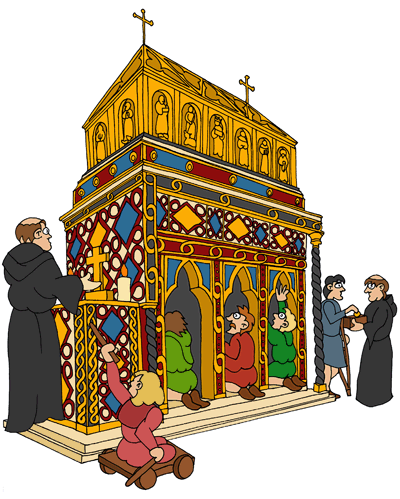|
Kids Home
London
Royalty
Romans
Early
Kingdoms
Berkshire
Teacher's Page
Mail David


|
|

Big Business in Medieval & Tudor
London
 When holy men or women died, people
thought that touching their grave, their dead body or their
possessions would cure them of all sorts of diseases and
afflictions. Some Christians still believe this. When holy men or women died, people
thought that touching their grave, their dead body or their
possessions would cure them of all sorts of diseases and
afflictions. Some Christians still believe this.- The church where they were buried
could apply to the Pope to have them made into a saint.
- A saints' bones and belongings they
once owned were called 'relics'. They were usually each kept in
a beautiful casket of gold or silver called a 'reliquary'. This
might be shaped like the relevant part of the body: a foot, an
arm or a head!
- Several of the monasteries
in London had big relic collections. Parish churches &
chapels might also have a single small relic.
- Bermondsey
Abbey had a stone cross that was supposed to have fallen
from the sky!
- Reliquaries containing major relics
or whole bodies were placed on an elaborate & brightly
painted stone monument called a 'shrine'.
- This had holes or niches into which
people could climb to get as near as possible to the saint's
body.
- There were two important shrines
like this in London: St. Edward the Confessor at Westminster
Abbey and St. Erkenwald at Old
St. Paul's Cathedral. People also visited the tomb of Rahere
at St.
Bartholomew the Great. He was not officially a saint.
- Individual bones were often swapped
with other churches. There was a great trade in buying and
selling relics. Many of them were probably fakes.
- Churches with relics or shrines
were visited by lots of people hoping for cures. They are called
'pilgrims'.
- The visit is called a 'pilgrimage'.
Pilgrims often travelled hundreds of miles on foot to visit
shrines. They would stay at the abbey's hospitium
when they arrived.
- In return, pilgrims gave money to
the monks or bishop who looked after shrines. They became very
rich.
- Pilgrims could sometimes buy
'indulgences' if they visited on special feast days. These were
documents would let them off some or all of a penance
(punishment) they might have been given when they confessed
their sins to a priest. The Eastminster
gave these out.
- The pilgrims ofen took away
'pilgrim's badges' made of pewter as souvenirs.
- The pilgrims of London were made
famous by Geoffrey Chaucer in the 14th century. He wrote a book
about a group of them travelling to St. Thomas
Becket's Shrine
at Canterbury Cathedral. It is called the 'Canterbury' Tales'.
- Pilgrims visited other places
associated with saints too: like the chapel in the Hospital of
St. Thomas of Acon (where St. Thomas Becket was born in
Cheapside) and his chapel on London Bridge (which had a piece of
the cross Jesus died on).
- Holy wells were also popular: like
St. Clement's Well (at St. Clement Danes), the Holy Well (at
Aldwych), St. Chad's Well (near Gray's Inn), the Clerk's
Well (at Clerkenwell) & St. Bride's Well (at Blackfriars). There were lots of others too.
- King Henry VIII put a stop to
pilgrimages during the Reformation. He had all the shrines &
relics destroyed. Only St. Edward the Confessor's Shrine
survived.
|
|

